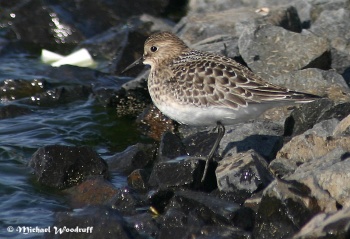(add some bits in Behaviour) |
Nutcracker (talk | contribs) (better pic) |
||
| Line 1: | Line 1: | ||
| − | [[Image: | + | [[Image:Baird's Sandpiper, Loveland, Colorado.jpg|thumb|550px|right|Spring adult<br />Photo by {{user|DJ+ODonnell|DJ ODonnell}}<br />Loveland, Colorado, [[USA]], April 2013]] |
;[[:Category:Calidris|Calidris]] bairdii | ;[[:Category:Calidris|Calidris]] bairdii | ||
==Identification== | ==Identification== | ||
[[Image:3337490 9078.JPG|thumb|350px|right|Juvenile<br />Photo by {{user|Michael+W|Michael W}}<br />UCA Sewer Ponds, Spangle, Spokane County, Washington, [[USA]], September 2005]] | [[Image:3337490 9078.JPG|thumb|350px|right|Juvenile<br />Photo by {{user|Michael+W|Michael W}}<br />UCA Sewer Ponds, Spangle, Spokane County, Washington, [[USA]], September 2005]] | ||
14-17.5cm (5½-7 in)<br /> | 14-17.5cm (5½-7 in)<br /> | ||
| − | '''Breeding | + | '''Breeding adult'''<br /> |
*Blackish-brown crown | *Blackish-brown crown | ||
*Gray-buff upperparts with 'scaly' appearance | *Gray-buff upperparts with 'scaly' appearance | ||
| Line 14: | Line 14: | ||
*Pale [[Topography#Heads|supercilium]] | *Pale [[Topography#Heads|supercilium]] | ||
*Short legs<br /> | *Short legs<br /> | ||
| − | Winter plumage similar; upperparts are plainer, with pale feather edges<br /> | + | '''Winter adult''' plumage similar; upperparts are plainer, with pale feather edges<br /> |
| − | Juvenile: head and breast markedly buff, with upperparts a little greyer, and giving a very scaly impression | + | '''Juvenile''': head and breast markedly buff, with upperparts a little greyer, and giving a very scaly impression |
| + | [[Image:Bairds_Sandpiper.jpg|thumb|350px|right|Juvenile<br />Photo by {{user|rayh|rayh}}<br />[[Flamborough Head]], North [[Yorkshire]], October 2004]] | ||
| + | |||
====Similar Species==== | ====Similar Species==== | ||
Compared to most other species, look for very long wings creating an elongated profile. This is to some extent shared with [[Sanderling]] and [[White-rumped Sandpiper]], and especially compared to the latter, look for all black, straighter bill and shorter legs. | Compared to most other species, look for very long wings creating an elongated profile. This is to some extent shared with [[Sanderling]] and [[White-rumped Sandpiper]], and especially compared to the latter, look for all black, straighter bill and shorter legs. | ||
==Distribution== | ==Distribution== | ||
| − | [[Image:IMG 4674a.jpg|thumb|350px|right|Photo by {{user|IanF|IanF}}<br />Seaton Snook, Seaton Carew. [[UK]], September 2012]] | + | [[Image:IMG 4674a.jpg|thumb|350px|right|Juvenile<br />Photo by {{user|IanF|IanF}}<br />Seaton Snook, Seaton Carew. [[UK]], September 2012]] |
Breeds in north-east [[Siberia]] on Wrangel Island and the Chukotski Peninsula and across northern [[North America]] to [[Greenland]]. | Breeds in north-east [[Siberia]] on Wrangel Island and the Chukotski Peninsula and across northern [[North America]] to [[Greenland]]. | ||
Revision as of 00:05, 5 April 2017
- Calidris bairdii
Identification
14-17.5cm (5½-7 in)
Breeding adult
- Blackish-brown crown
- Gray-buff upperparts with 'scaly' appearance
- Whitish underparts
- Brownish breast
- Wing tips extend well past tail
- Black rump
- Narrow, fine-tipped bill
- Pale supercilium
- Short legs
Winter adult plumage similar; upperparts are plainer, with pale feather edges
Juvenile: head and breast markedly buff, with upperparts a little greyer, and giving a very scaly impression
Similar Species
Compared to most other species, look for very long wings creating an elongated profile. This is to some extent shared with Sanderling and White-rumped Sandpiper, and especially compared to the latter, look for all black, straighter bill and shorter legs.
Distribution
Breeds in north-east Siberia on Wrangel Island and the Chukotski Peninsula and across northern North America to Greenland.
In winter found in South America from southern Ecuador to Tierra del Fuego. Main migratory route in autumn is via the Great Plains in late July-August, juveniles migrate rather later and sometimes wander to eastern Canada. Spring movement across North America is mainly in April-early May, again most travel through the interior.
In the Western Palearctic recorded in many European countries north to Iceland, Scandinavia and Poland and south to Greece, also on the Azores.
However, most records come from Britain (c.170) where now up to 6 are recorded annually, mainly in July-October and very occasionally in spring. Most occur in the south-west but there have been many east coast records, suggesting that some may arrive from the east.
Taxonomy
This is a monotypic species[1].
Habitat
Usually seen on freshwater marshes, riverbanks and lakesides rather than coastal habitats but also on coastal and brackish marshes and adjacent grassland.
Behaviour
Breeding
Breeding season starts in June, sometimes early July. A monogamous species. The nest on the ground, usually in dry locations with low vegetation. Lays four, sometimes three eggs.
Diet
During breeding season the diet consists mainly of insects. On migration feeds on larvae of beetles, Diptera, Coleoptera and Lepidoptera. Pecks up prey with quick bill jabs, generally shows a brisk feeding action.
Movements
A migratory species, many birds migrate inland across the North American prairies, Rockies and northern Andes, resting at high-altitude lakes.
Adults depart in early July from breeding grounds, failed breeders from late June. Females slightly preceding males. Juveniles migrate later from their breeding grounds, in late July, reaching Patagonia in early October.
Vocalisation
Call: a purring prrreet
References
- Clements, J. F., T. S. Schulenberg, M. J. Iliff, D. Roberson, T. A. Fredericks, B. L. Sullivan, and C. L. Wood. 2016. The eBird/Clements checklist of birds of the world: v2016, with updates to August 2016. Downloaded from http://www.birds.cornell.edu/clementschecklist/download/
- Collins Field Guide 5th Edition
- Collins Bird Guide ISBN 0 00 219728 6
- USGS
- Handbook of the Birds of the World Alive (retrieved March 2017)
- Wikipedia
Recommended Citation
- BirdForum Opus contributors. (2024) Baird's Sandpiper. In: BirdForum, the forum for wild birds and birding. Retrieved 4 May 2024 from https://www.birdforum.net/opus/Baird%27s_Sandpiper
External Links







